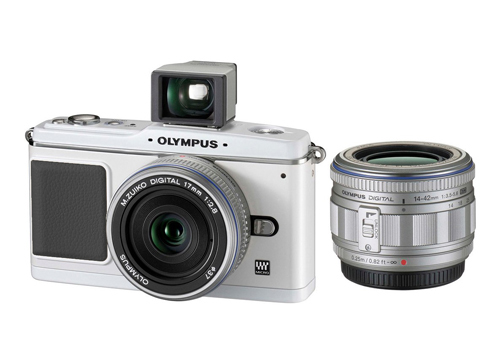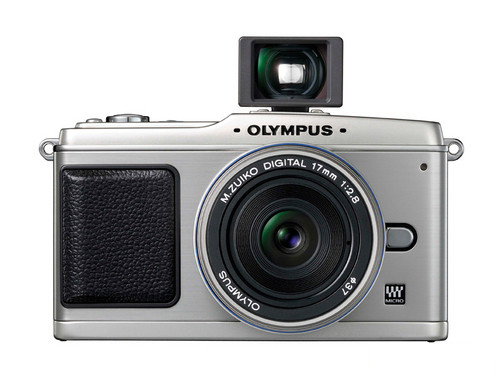Although the official announcement of the new Olympus E-P1 will be tomorrow afternoon, June 16th in Tokyo, images and specs have appeared all over the net. The camera will come with a 12.3 mp livemos sensor and a 3″ LCD screen with 230,000 pixels. In auto mode the ISO range will be from 200 to 3200 and in manual mode from 100 to 6400. The first sample images can be seen here.

The camera will have the following file formats: 12 bit RAW, jpeg, RAW + jpeg, and AVI motion jpeg. Both sRGB and AdobeRGB are available as color spaces. The camera will be able to capture a maximum of 10 RAW photographs in a burst. It can capture images in the image ratios 4:3, 3:2, 16:9, and 6:6. And when you shoot in RAW the image ratio will recorded in the EXIF data. The first lenses to be released will be a 14-42mm f/3.5-f/5.6 zoom lens and a 17mm f/2.8 prime lens.
The camera will also have a 30 fps 720p HD movie mode. Recording will be on SD and SDHC cards with a maximum duration of 7 minutes in HD mode and 14 minutes in SD mode.

Update June 16, 2009:
The camera is now officially announced. For more news about the E-P1 see the Olympus PEN site and the hands-on preview at dpreview.com.
Hello Wouter,
and yes, a very interesting “serious compact” and maybe an alternative to the sigma dp series.
We will see.
Best regards,
titus
Size and feature wise this is an interesting camera, although it does look a bit too much of a gimmick to me. I would have preferred to see the Olympus black dSLR finish.
Looks pretty interesting. Like a DP-1,2 done right. I’ll be interested to read the reviews.
Seriously Eric, I think the DP1 and DP2 are done quite right. Just not what everybody had hoped for.
in europe, you can sign up to “TEST A PEN”:
[url]http://www.olympus-europa.com/consumer/pen.htm?olycmp=912222#intro[/url]
Wouter,
you are the number one person i would love to see test it out! not saying to buy it (this is for a chance to test drive), simply that i would love to see it in your hands and know your impressions.
I would love to test one Cam. I do remain reserved though. I must admit that I like Kevin’s combination with the R-glass.
Very, very tempting, but…
Aperture change, how? with menu? that’s a shame if there is a scrollwheel.
Manual focus change, the same..
but really nice!
It looks pretty good. But I personally only like the combination with the 17mm lens.
Ronald, there appears to be two scrollwheels on the back of the camera (not unlike higher end DSLR or my Ricoh GX-100), and you can assign your own functions to these (I think).
Definetly my next camera, glad I didn`t bought the DP-2
Keep us informed Arild.
Looks very good and how a compact camera with big sensor should look like. There is a very good preview of it on DP Review and I really like the samples with the b&w Art filter.
My only concern now is the lack of fast wideangle lenses for m4/3, reports about slow AF and in camera lens corrections. This is what keeps me from rushing out and getting one, otherwise it is exactly what I want and I hope Ricoh will release something very similar very soon.
In my opinion this is the only way to go for Ricoh. I personally like the 17mm lens and find it pretty good for most of my photography. I hope Ricoh will not try to deal with a smaller sensor. I think fast wideangle lenses will be even tougher to develop.
I don’t really mind in camera lens correction as long as the RAW photographs can be opened in your favorite editing software and you don’t get huge DNG files.
I think that we don’t need to worry too much about the in-camera corrections for distortion. I’ve only just figured this out. It’s true that you lose some resolution with software correction of distortion. But the elements introduced to make a lens perfectly rectilinear also lose resolution (that’s why fisheyes can be so sharp despite being so wideangle). So you *gain* resolution by leaving distortion uncorrected in the lens, and then you lose it again by software correction. So on balance, nothing lost nothing gained: except, of course, the lens can be much smaller!! So from having been very opposed to it, I now think it’s likely fine.
I don’t think it is something to be worry about too, but what worries me could be the restriction in using your favorite RAW processor. When it comes to in-camera processing the E-P1 seems to do a pretty good job.
I have been a bit disappointed in the first photographs I saw from the 17mm lens wide open. The boked seemed mushy and not creamy.
That’s a pity. Still I didn’t expect much Bokeh; the 17mm wide open at f2.8 has similar filed of view and depth of field to a 35mm lens at f5.6 on full format. Which isn’t much. The Panasonic 20mm 1.7 will be equivalent in field of view and depth of field to about a 40mm f 3.5 which allows for a little more bokeh. Also, I suppose the aspheric elements in these little lenses makes the bokeh a bit uglier when there is some.
But it should be easy to put something like an old OM 50mm 1.4 onto it, and that gives you a 100mm f2.8 equivalent. But I think the bottom line is that there’s no substitute for a larger sensor for bokeh.
What does excite me a bit is the little panasonic 7-14; it doesn’t have stabilization but on the e-p1 it’ll be stabilized! I fear I won’t be able to afford it though.
Yes the restiction on RAW could be a nuisance. But I expect that Adobe will support it soon in corrected form, and then RPP or DCraw could be used if you want uncorrected images for a little extra sharpness at the expense of resolution.
What I have noticed is that Adobe applies not just correction, but quite a lot of luminance noise reduction to LX3 files even when you turn the NR to zero. So there is a real reason for having access to the uncorrected file there – it’s much sharper. I think it must be under instruction from panasonic. I hope they don’t do the same with the Olympus.
oops I meant sharpness at the expense of distortion in the second last para!
I do suspect Olympus applies some additional unchangable processing too. When I opened some E-P1 RAW files in Lightzone, I was suprised to see how dark they were opened. And when I increased the exposure it was just all noise.
I really like the look and concept of this camera. But the PRICE. Its £699 in the UK. Its just not worth that sort of money. Its a lot to pay for an in-your-pocket camera – it doesn’t attract me. I think the price point of the product and the DP2 is way too much. Certainly, it has much to offer tho and I think that this and the Panasoic G1 is the way things are going to go. The DSLR is dead, its all going to go over from an optical finder with a reflex mirror to a high resolution EVF (I know the EP1 doesn’t have an EVF). In five years time the only DSLRs with optical finders will be high-end full frame pro cameras.
I personally hate the thought of EVF’s. If so, than a dSLR is the way to go for me. Would you trade your S5pro for such a smaller camera?
I have to say I like using EVFs and I am ordering the Panasonic G1 on Monday as a back-up camera (and to use as my mountaineering camera). I shot a wedding a few weeks ago and this is the sole reason I use the Fuji S5 – its Dynamic Range. It is HUGE and quite incredible. The wedding day was very bright contrasty Sun (VERY rare for the UK that) and 628 pix later not one of them had blown highlights. I like using the EVF on my GX100. I don;t like hold the camera at arms length. I DON’T LIKE IT. I feel detached from my subject holding the camera at arms length, its like I am holding the subject away from me. If I am holding the camera to my eye I feel like I am involved with my subject instead of looking at my subject on a screen. Do you know what I mean?
To answer your question my friend, probably – if the camera is good enough. I’ll let you know how the G1 stacks up against the S5.
All the best Wouter. Keep the great pix coming.
I love to hear your impressions of the G1 from you, Chris.
I totally understand your thing with the LCD screen and holding the camera at arms length. Since using the DP1 with the OVF, I can’t do without it. I even use it for the Ricoh and it is superb.
I’ve read it before that the S5 is a camera for wedding photographers. The dynamic range and beautiful skin tones as the most important reasons.
Cheers,
Wouter